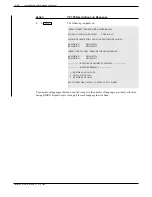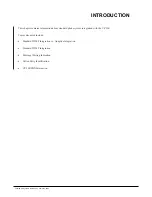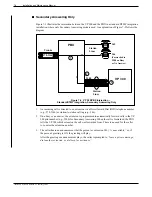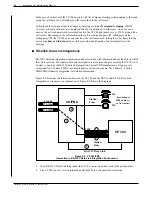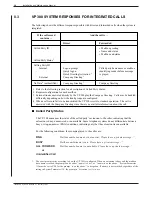
ADAPTIVE INTEGRATION
Adaptive Integration (AI) enhances VP 300 operation beyond Standard DTMF Integration (see Standard
DTMF Integration vs. Adaptive Integration in the previous chapter for a comparison). AI takes advantage
of PBX/CO-provided call status and message waiting indication functions implemented by some means
other than or in addition to DTMF mailbox digits prefixed to a call. Depending on the method a particular
PBX uses to send call records and control indicators, the VP 300 may be equipped with proprietary
integration cards or an RS–232C data link.
The Adaptive Integration feature enhances Message Waiting Indication (MWI) and Called Party
Identification (CPI) significantly. AI enables the VP 300 to process MWI control signals from RS-232C or
proprietary data links and expands CPI to a full data exchange capability where the PBX/CO and the VP
300 can pass calls and messages back and forth without the need to supervise call progress.
Message Waiting
In addition to lamp indicators and stutter dial tone, integrated VP 300 systems
Indication (MWI)
can send information via the data link that may allow the PBX/CO to display a
message on a display phone. Some phone systems still use DTMF tones to
activate MWI even if the identity of the called person is provided by the data
link. The VP 300 can handle any combination of MWI and CPI methods
because they are independent features.
Called Party
In an integrated VP 300, and depending on PBX/CO functions, CPI can expand
Identification (CPI)
well beyond the simple identification of the called party's extension and
mailbox. Adaptive Integration relies on phone system station forwarding to
deliver the call to the VP 300. If the PBX/CO is capable of sending a detailed
call record to the VP 300, an integrated system collects the call record via
DTMF tones or data link and associates the information with the port the call is
received on. Then, using the information in the call record, the VP 300 responds
with appropriate prompts and actions determined by the system configuration.
CPI Call Records
A call record format and its contents depend on the phone system manufacturer,
model, and configuration. Call handling can be tailored according to the
information provided by the call record. Following are the types of information
a call record may contain:
•
Called Party ID
•
Called Party Status (busy/no answer/all calls forward)
•
Calling Party ID
•
External — Trunk ID
•
Internal — Extension/mailbox ID
•
Forwarded — Secondary Answering Call Coverage
•
Direct — Primary Answering
Toshiba VP Systems Release 6.1 February, 1993
ADAPTIVE INTEGRATION
8-1
8.1
Содержание VP 300
Страница 2: ......
Страница 10: ......
Страница 14: ......
Страница 19: ...Quick Reference Guide Hardware Toshiba VP 300 System Specifications Toshiba VP Systems Release 7 1 July 1994 ...
Страница 20: ...Toshiba VP Systems Release 7 1 July 1994 ...
Страница 52: ...Toshiba VP Systems Release 6 1 February 1993 2 14 Installation and Maintenance Manual ...
Страница 56: ...Toshiba VP Systems Release 7 1 July 1994 ...
Страница 146: ......
Страница 312: ...Toshiba VP Systems Release 7 1 July 1994 ...
Страница 314: ......
Страница 444: ......
Страница 496: ......
Страница 542: ......
Страница 598: ...Toshiba VP Systems Release 6 1 February 1993 ...
Страница 600: ...Toshiba VP Systems Release 6 1 February 1993 ...






